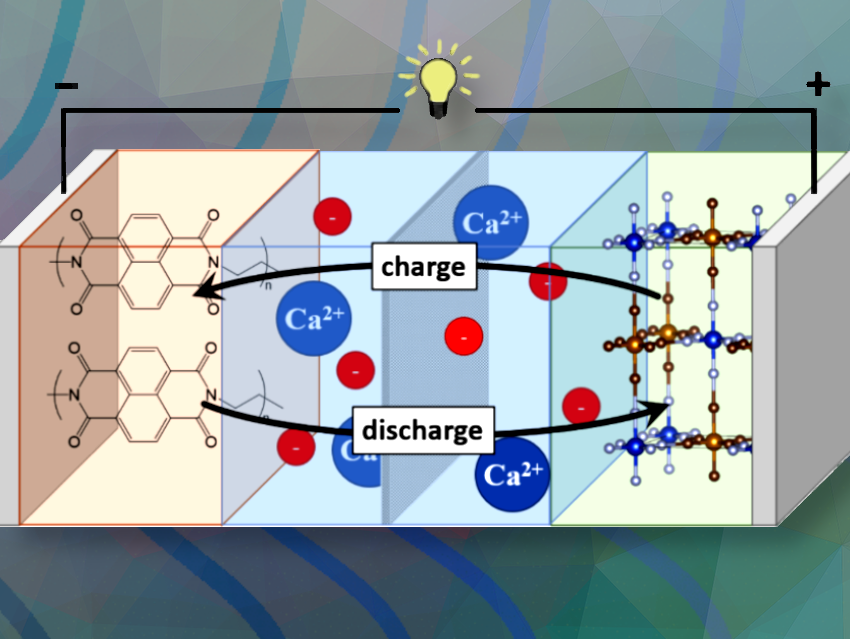Raphael Streng and colleagues at Technische Universität München (TUM), Germany, have studied the effects of the cation choice on the stability of electrode materials in aqueous batteries.
What did you do?
We developed a sustainable aqueous calcium-ion battery consisting only of abundant and low-cost materials.
By investigating the stability of a copper hexacyanoferrate cathode and a polyimide anode in different electrolyte solutions, we found that replacing monovalent K+ ions with divalent Ca2+ ions in the electrolyte significantly enhances the cycling stability of both electrodes. Following these results, we proposed a highly stable aqueous battery based on saturated CaCl2 with excellent fast charging capabilities.
Why are you interested in aqueous batteries?
As energy production is transitioning towards renewable sources such as solar and wind power, energy storage gains importance to compensate for natural power generation fluctuations associated with these systems. Batteries are among the best candidates for grid-integrated, efficient, and flexible energy storage.
While lithium-ion batteries (LIBs) dominate due to their energy density, concerns over lithium scarcity and safety have renewed interest in safer, cost-effective alternatives like aqueous batteries. Using abundant salts, these batteries offer advantages in stationary storage and public transport due to their safety, sustainability, and fast-charging potential.
However, their limited cycle life and energy density constrain their viability, necessitating strategies to mitigate degradation and extend cycle life. The standard strategy of using highly concentrated water-in-salt electrolytes relies on relatively expensive and less sustainable materials. Hence, we investigated a novel, cost-efficient approach using only abundant CaCl2.
What is new and cool about your research?
Most research focuses on systems based on one particular cation, such as K-ion or Ca-ion batteries. Various strategies have been proposed to improve the stability of these batteries, but the effect of the cation itself is rarely discussed.
We show that by simply switching to a different cation system, the performance of the same battery can be significantly enhanced. Our model battery is cheap and easy to produce, stable, capable of ultra-fast charging, and does not incorporate any scarce, toxic, or harmful materials.
What is the main significance of your results?
We show that the electrolyte cation significantly influences the stability of the used electrode materials. Particularly, the copper hexacyanoferrate cathode displays almost doubled capacity retention after cycling in CaCl2 compared to KCl.
Further improvements can be achieved by using saturated electrolyte solutions as they inhibit active material dissolution, enabling a stable and fast aqueous battery for sustainable energy storage. These findings can also be used to develop new electrolyte design strategies for other battery types.
What specific applications do you imagine for your battery?
While aqueous batteries generally suffer from relatively low energy densities, the proposed battery offers high cycling stability and fast-charging capabilities. This renders it ideal for stationary storage systems, as economically viable large-scale applications require scalability, cheap and abundant raw materials, safety, long cycle life, and sustainability. The exceptional rate capability enables supercapacitor-battery hybrid systems, which may be useful for electrified public transport.
To evaluate the implementation potential of these batteries, further studies on their upscaling will be needed.
What part of your work was the most challenging?
One of the biggest challenges was the transition from single-electrode investigations to developing full cells reliably delivering the expected specific energies and capacities. Since mass balancing and cell architecture strongly influence battery performance, achieving reproducible results requires careful electrode production and cell assembly.
Is there anything else you would like to add?
The success of this project was only possible due to the productive collaboration between me (Raphael Streng), our group leader Professor Bandarenka, and my bachelor’s and master’s students. By carrying out many of the shown measurements the students S. Reiser, S. Wager, and N. Pommer contributed significantly to this work, which highlights the great potential of involving young researchers in the development of materials and systems for a more sustainable future.
Thank you very much for these insights.
The paper they talked about:
- A Fast and Highly Stable Aqueous Calcium-Ion Battery for Sustainable Energy Storage,
Raphael L. Streng, Samuel Reiser, Sabrina Wager, Nykola Pommer, Aliaksandr Bandarenka,
ChemSusChem 2024.
https://doi.org/10.1002/cssc.202401469

Raphael Streng is a Ph.D. student in the Energy Conversion and Storage group at Technische Universität München (TUM), Germany.
His research focuses on lithium-free aqueous batteries, with a particular emphasis on how electrolytes interact with different active materials and on advancing sustainable battery solutions for large-scale energy storage applications.





